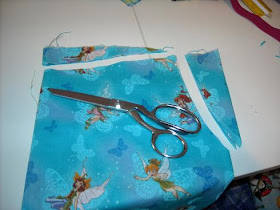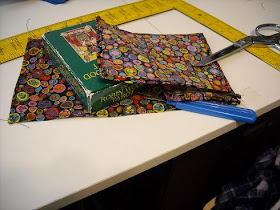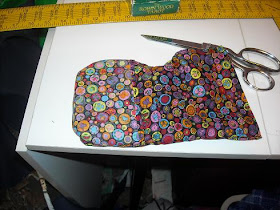 This one's a little seasonal -- and maybe it's on my mind because I've eaten so much candy corn lately! I just can't resist those things!
This one's a little seasonal -- and maybe it's on my mind because I've eaten so much candy corn lately! I just can't resist those things!This fits in the one-yard framework -- to make 6 pillows (about 10 inches high), use 1/2 yard of orange, 1/4 yard of yellow, and 1/4 yard of white. I used el cheapo poly broadcloth -- next year I'll watch the sales and pick up some cotton when it's on sale.
You'll also need some polyfil. One bag will easily fill six pillows.
You can do most of the sewing on your machine with a straight stitch -- there's a tiny bit of hand slip-stitching involved when you close the pillow.

To begin, cut (or tear) off a 6 inch strip of orange -- end result will be 6 inches high by 44 inches wide. Then, cut off a 3 inch strip of yellow -- resulting in 3 inches high by 44 inches wide. Finally, cut a 3 inch by 44 inch wide piece of white. I said "cut", but I really just cut a little snip, then tore the fabric across the width of the fabric.

Join the pieces in "candy corn" order -- yellow, orange, white -- then sew them together using a 1/4 inch seam allowance. You'll join them just like you were piecing things together for a quilt. Be sure the yellow/orange seam ends up on the same side as the orange/white seam!
In this picture, I have the white side on top of the orange side -- since the orange is 6 inches and the white is 3 inches, half of the orange is under the white strip.
When you're done, you have a candy-corn colored strip of fabric, 12 inches high and 44 inches wide! One side has seams; the other side doesn't.
I ironed my seams towards the middle; I figured the seam allowance might show if it underlayed either the white or the yellow strip. Since the orange is darkest, I wanted the seam allowance beneath it.
Now, fold the strip in half -- yielding a 12 inch high by 22 inch wide folded piece.
Match the corners and sides very carefully --
now ...
Fold the strip again in half -- yielding a 12 inch high by 11 inch wide folded piece (it'll have four layers). We'll cut this stack to make four sides for our candy corn pillows (yielding 2 complete pillows).

You can make a candy-corn shaped template if you'd like -- or you can just eyeball like I did. I marked off three inches in the center of the white top. I then cut an angle from one edge this three inch white section down to just inside the yellow corner.
Next, I did the same thing on the other side of the piece. I didn't cut down to the exact yellow corners -- I wanted to make sure I cleared all the folds.
The two edges are scrap.
Now, take the top two pieces from the stack. Match good sides together (seams on the outside. Pin the pieces together, then sew them together -- use about a 1/4 seam allowance.
Leave a gap on the bottom -- maybe three inches or so.
When you get to the white and orange corners, sew a curved seam. Again, you can get fancy and use a template with curved corners -- or you can just eyeball the curves. When done, you can trim the corners to match the curves.

Almost done -- invert the pieces so the good side is on the outside (seams on the inside). Grab handfuls of you polyfil and start stuffing your pillow through the gap you left on the bottom!
Work the stuffing in to fill all the edges as best you can. You can continue to work the stuffing even after you've sewn the gap closed.
Once you've stuffed your candy corn, you'll hand-stitch it closed. I used a slip-stitch and yellow thread. Pinch the gap closed and handsew.
And here're my first-two pillows! These pillows are about 11 inches tall -- you can adjust your measurements to make your pillows whatever size you feel is best.
Note the jack-o-lantern pillows -- I made these using my removable, decorative holiday pillow covers.












































